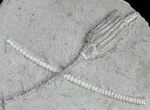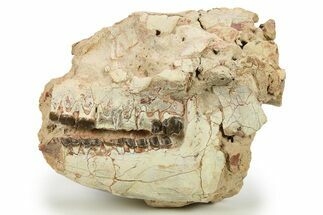This Specimen has been sold.
9.4" Agaricocrinus & Macrocrinus Crinoid Plate - Indiana
Here are several detailed crinoids from the Ramp Creek Limestone of Indiana. There are two Agaricocrinus americanus, a pair of Macrocrinus mundulus and a Catillocrinus tennesseeae. This is a composite plate meaning the fossils were found individually, mostly free of the rock and attached to the rock for the display purposes. The price reflects that it is a composite piece.
It is believed that crinoids from the Ramp Creek Limestone were buried in sediment from nearby deltas during storms. The resulting siltstone deposits are soft enough that fossils can be extracted in exquisite, three-dimensional relief.
It is believed that crinoids from the Ramp Creek Limestone were buried in sediment from nearby deltas during storms. The resulting siltstone deposits are soft enough that fossils can be extracted in exquisite, three-dimensional relief.
Crinoids, sometimes commonly referred to as sea lilies, are animals, not plants. They are echinoderms related to starfish, sea urchins, and brittle stars. Many crinoid traits are like other members of their phylum; such traits include tube feet, radial symmetry, a water vascular system, and appendages in multiples of five (pentameral). They first appeared in the Ordovician (488 million years ago) and some species are still alive today.
SPECIES
Agaricocrinus americanus, Macrocrinus mundulus
LOCATION
Crawfordsville, Indiana
FORMATION
Ramp Creek Limestone
SIZE
Matrix 9.4x5"
CATEGORY
SUB CATEGORY
ITEM
#42989
We guarantee the authenticity of all of our specimens.
 Reviews
Reviews














